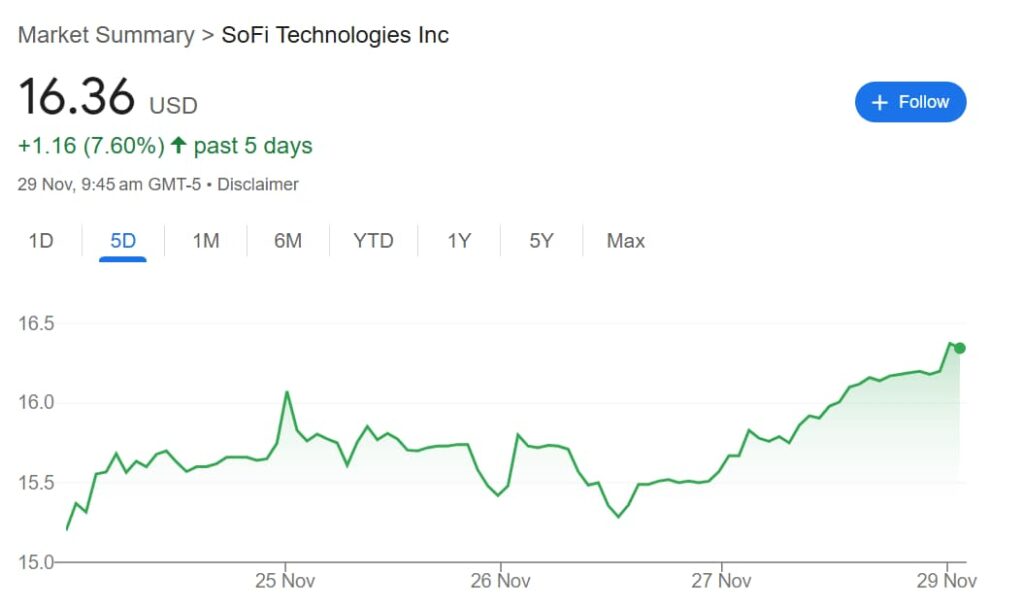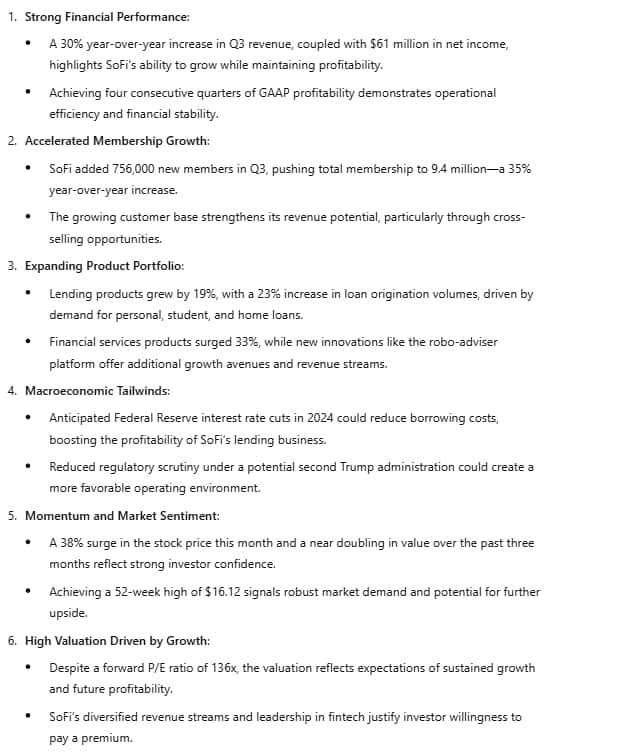SoFi Technologies (NASDAQ: SOFI) has captured the spotlight in the market, with its stock surging 56% this month and nearly doubling in value over the past three months. Currently trading at $16.36, the stock has reached a 52-week high.
The fintech giant’s rally has been driven by strong Q3 earnings, record member growth, and optimism about potential regulatory rollbacks under a second Trump administration.
Jim Cramer, the outspoken host of CNBC’s Mad Money, urged investors to go long on SoFi earlier this year, a recommendation now seemingly validated by the company’s impressive performance.

As SoFi continues its rise, the focus shifts to whether the stock can sustain its momentum, justify its lofty valuation, and define its trajectory heading into year-end 2024.
Key factors driving SoFi Technologies (SOFI) stock price
One of the core factors propelling SoFi’s stock is its outstanding Q3 results, which revealed a 30% year-over-year increase in revenue and a net income of $61 million, marking its fourth consecutive quarter of GAAP profitability.
Membership growth has been a standout metric, with SoFi adding over 756,000 new members in the quarter. This brought the total membership to 9.4 million, representing a 35% year-over-year increase and solidifying its appeal among tech-savvy consumers.
The company also recorded a 19% increase in lending products, driven by heightened demand for personal, student, and home loans. Loan origination volumes surged by 23%, reflecting SoFi’s ability to capture market share in the lending space.
Meanwhile, its financial services products grew 33%, reaching 11.8 million, while the technology platform segment posted a 14% revenue increase. Although the tech platform remains the smallest contributor to overall revenue, it plays a critical role in SoFi’s broader transformation into a diversified financial ecosystem.
This mix of strong fundamentals and sustained growth across multiple verticals has fueled optimism among investors, cementing SoFi’s position as a fintech powerhouse.
Innovation and macroeconomic tailwinds
Innovation has also played a pivotal role in SoFi’s success. The company recently launched a robo-adviser platform that provides automated investment solutions, offering a new revenue stream and enhancing its cross-selling potential.
Coupled with its existing digital-first banking model, SoFi’s ecosystem continues to attract young, tech-savvy customers.
This growth has been further supported by macroeconomic factors such as expectations of less regulatory scrutiny under a potential second Trump presidency and the likelihood of interest rate cuts by the Federal Reserve, which could benefit SoFi’s lending business.
High valuation: A double-edged sword for SoFi
Despite these positive developments, analysts remain cautious due to SoFi’s high valuation metrics. With a forward P/E ratio of 136x, as reported by StockAnalysis, SoFi’s valuation significantly exceeds the industry median, reflecting high investor expectations and leaving minimal room for execution errors.
However, with its diversified revenue streams, expanding product offerings, and robust growth trajectory, SoFi remains an attractive choice for long-term investors, particularly as it continues to redefine the boundaries of fintech innovation.
AI prediction for SOFI stock by year-end
Finbold consulted OpenAI’s ChatGPT-4o for insights into SoFi’s potential year-end price. Based on SoFi’s robust growth metrics, expanding revenue streams, and favorable macroeconomic outlook, the AI model predicts the stock could reach $19 to $21 by December 2024.

This target accounts for continued member growth, further monetization of new products like the robo-adviser platform, and a reduction in cost pressures from lower interest rates. However, achieving this range will require flawless execution, particularly given SoFi’s high valuation metrics.
Featured image via Shutterstock







